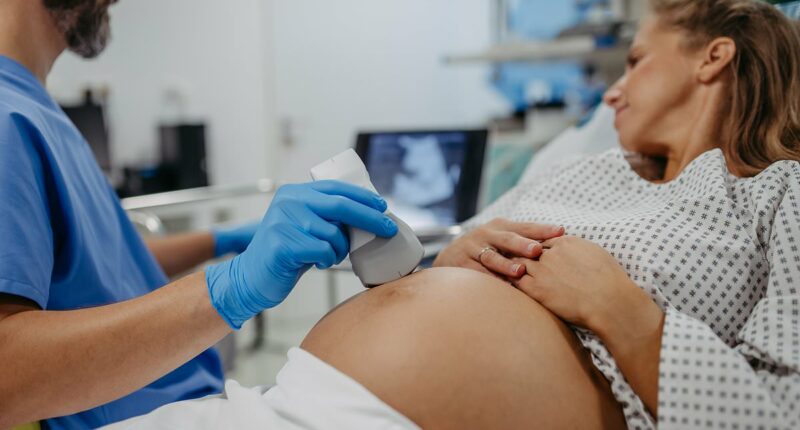Share this @internewscast.com
Up to 53 million American women of childbearing age have at least one risk factor that increases the odds of severe birth defects.
A CDC study, drawing on survey responses from over 5,300 women aged 12 to 49, found that more than 66 percent had at least one risk factor: obesity, diabetes, a history of smoking, food insecurity, and low levels of an important mineral known as folate. Over 10 percent of these women had three or more risk factors.
Researchers utilized data from the National Health and Nutrition Examination Survey (NHANES), a comprehensive dataset from the CDC, covering health information from 2007 to 2020.
In this study, around 34 percent of women were classified as having obesity, approximately five percent had diabetes, and 80 percent were deficient in folate, also referred to as vitamin B9, which is vital during pregnancy to help prevent brain and spinal cord birth defects.
Additionally, about one in five women were found to be exposed to nicotine through smoking, vaping, or second-hand smoke, known from previous studies to significantly elevate the risk of premature birth, low birth weight, stillbirth, and Sudden Infant Death Syndrome (SIDS).
Seven percent of women faced challenges in affording nutritious food, which can lead to poor fetal nutrition and increase the future risk of obesity. The study noted that women experiencing food insecurity might have difficulty affording prenatal vitamins, eating healthily, or managing their weight effectively.
Birth defects, impacting one in 33 babies, are a major contributor to infant mortality, responsible for nearly one in five infant deaths. These defects can range from minor issues like webbed toes or a club foot to severe conditions such as anencephaly, where parts of the brain and skull do not form, or Trisomy 13, which results in malformed organs. They represent a leading cause of infant death, accounting for about one in five cases.
The risk factors researchers considered raised the risks of babies being born with heart defects, such as improperly formed valves, neural tube defects such as spina bifida, and orofacial clefts, including cleft lip and cleft palate.

A CDC study found that two-thirds of American women of reproductive age have at least one major risk factor, such as obesity, smoking, food insecurity, or low folate levels, that can increase the chance of birth defects (stock)
While the exact causes of birth defects are often unknown, scientists generally agree that a complex mix of genetic predispositions, environmental influences, and lifestyle choices is at play.
Around 25 percent of birth defects are caused by genetic or chromosomal abnormalities, including conditions like Down syndrome, which is caused by an extra chromosome.
Environmental causes, such as infections in the pregnant mother, maternal diabetes, nutritional deficiencies like a lack of folate, and exposure to certain drugs account for five to 10 percent of birth defects, according to the NIH.
Scientists estimate that ‘complex genetic or unknown causes’ are behind 65 percent of most birth defects, the NIH scientists reported.
They are not caused by a single faulty gene, but rather, a complex interplay between genes interacting with each other or a combination of genetic predispositions and unknown environmental influences.
The study did not explain exactly how the risk factors lead to birth defects, but cited the one-carbon cycle, a network of chemical reactions in the body that uses nutrients like folate, vitamin B12, and choline to make DNA, regulate genes, and support cell growth.
If the cycle malfunctions, such as when folate is low during pregnancy, it can disrupt DNA synthesis and cell division in a developing embryo. This increases the risk of birth defects, particularly neural tube defects like spina bifida and deadly anencephaly.
Scientists are still trying to work out how exactly the health of the mother leads to malformations in their babies. Still, past research has shown that obesity and diabetes can change how the body processes folate and other nutrients. At the same time, smoking introduces toxins that interfere with folate metabolism and increase oxidative stress.

Birth defects are a leading cause of death in infants, accounting for about one in five. Non-Hispanic Black women bore the highest burden, with 80 percent having at least one risk factor versus 62 percent of white women
Researchers said: ‘Previous studies have suggested that these risk factors may be attenuated through the consumption of folic acid (FA) periconceptionally and during organogenesis.
A developing fetus needs folate to make healthy new cells as well as to make DNA and RNA. Folate is also essential for the formation of normal red blood cells and amino acids.
Doctors recommend folic acid supplements, which are made up of the synthetic form of folate, over dietary folate alone, as they are more reliably absorbed in the body.
Women can get natural folate from a variety of foods, with the best sources being dark leafy greens such as spinach and kale, lentils and other legumes, asparagus, avocados, and broccoli.
Citrus fruits, nuts, seeds, and fortified foods like cereals and breads, which contain the synthetic form, folic acid, are also excellent sources of the key nutrient.
Women who may become pregnant should take a supplement containing 400 micrograms of folic acid. But those who lack access to nutritious food are less likely to take supplements for prenatal health.
Nearly seven percent of women faced severe food insecurity, meaning they regularly struggled to afford enough food. When it came to crucial prenatal nutrients, the data revealed that while about 28 percent of women took a folic acid supplement, only 13 percent were taking the recommended daily dose of 400 micrograms.
Ninety-nine percent of women were not getting enough folic acid from food alone, and even when supplements were included, eight in 10 still fell short of the recommended amount.
Deficiencies were confirmed by blood tests, which showed that one in five women had folate levels low enough to increase the risk of severe neural tube defects, severe disorders in babies that occur in the first month of pregnancy, where the embryonic structure that forms the brain and spinal cord fails to close properly.
The study found that while less than half of women in their teens and early twenties had risk factors, that number jumped to nearly three-quarters of women aged 35 to 49, mainly because the prevalence of conditions like obesity and diabetes increases with age.
The analysis also uncovered stark racial and economic disparities. Non-Hispanic black women faced the highest burden, with 80 percent having at least one risk factor, compared to 62 percent of non-Hispanic white women.
Non-Hispanic black women also had the highest rates of severe food insecurity and the lowest levels of folate.
Similarly, women living in poverty were far more likely to have multiple risk factors compared to those with higher incomes.
The latest findings were published in the American Journal of Preventive Medicine.
The vast majority of birth defects are chronic, such as microphthalmia, which causes lifelong vision impairment; Spina Bifida, which requires a lifetime of mobility assistance, bladder and bowel function help, and potential for fluid on the brain; and Down Syndrome, which carries lifelong implications, including intellectual disability, possible heart defects, and higher risks for other health conditions.
















